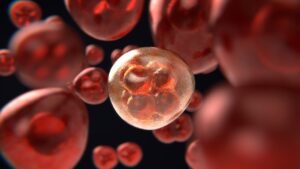Prostate Cancer!

Prostate Cancer Introduction
Researchers from the University of Oxford have developed a new method using a glowing dye that may help surgeons better detect and remove prostate cancer cells. This innovation has the potential to improve surgical outcomes and reduce the risk of cancer recurrence. Here’s a detailed look at this breakthrough.
Overview
- Purpose: To assist surgeons in identifying and removing prostate cancer cells that are not easily seen by the naked eye.
- Innovation: A fluorescent dye that attaches to a specific protein found only on cancer cells.
How the Glowing Dye Works
- Targeted Approach: The dye binds to a protein unique to prostate cancer cells, causing them to glow under certain lights.
- Enhanced Visibility: This glowing effect helps surgeons to spot cancerous areas that might be missed using traditional methods.
Early Trial Success
Trial Details
- Participants: 23 men undergoing prostate cancer surgery.
- Findings: The dye helped surgeons locate cancerous tissue that had spread to nearby areas, such as lymph nodes, which they might have missed otherwise.
- Significance: This was the first time such a method was tested on humans in the UK, with results published in the European Journal of Nuclear Medicine and Molecular Imaging.
Patient Case: David Butler
- Detection: The dye revealed cancer in David’s lymph nodes and bladder.
- Outcome: Following surgery and radiotherapy, David has been clear of cancer, considering himself very fortunate.

Next Steps: Larger Promote Study
- Objective: To evaluate the effectiveness of this method on a larger scale.
- Funding: Supported by Cancer Research UK (CRUK).
Comments from Experts
- Prof Freddie Hamdy: Lead researcher
- Quote: “In many patients, we saw cancer that we would not have seen otherwise.”
- Benefit: Potential to remove all cancerous cells during surgery, including those that have spread, while preserving more healthy tissue.
- Dr. Iain Foulkes: Executive director of research and innovation at CRUK
- Quote: “We need better tools to spot cancers that have started to spread further. This dye could transform how we treat prostate cancer.”

Advantages of the New Method
Improved Cancer Detection
- Real-time Visualization: Allows surgeons to see fine details of prostate cancer during surgery.
- Comprehensive Removal: Helps ensure all cancerous cells are removed, including those that have spread from the original tumor.
Reduced Side Effects
- Tissue Preservation: This may allow for more healthy tissue to be preserved during surgery.
- Fewer Complications: This could reduce side effects such as erectile dysfunction and incontinence, which are common after prostate surgery.
Potential Future Applications
- Adaptability: If successful, the dye might be adapted for use in surgeries for other types of cancer as well.
- Wider Impact: This could lead to a significant shift in cancer treatment strategies by providing better tools for detecting and removing cancerous tissues.
Conclusion
The introduction of glowing dye technology in prostate cancer surgery represents a significant and promising advancement in the field of oncology. This innovative approach provides surgeons with a powerful and precise tool for the detection and removal of cancerous cells, potentially transforming the landscape of prostate cancer treatment.
The glowing dye, which is administered before or during surgery, enhances the visibility of cancerous tissues by emitting fluorescence. This allows for real-time imaging of the tumor and its surrounding tissues, enabling surgeons to accurately pinpoint and excise malignant cells that might otherwise be difficult to detect. The improved visualization helps ensure that all cancerous tissue is removed while minimizing the impact on healthy surrounding tissues. This precision can lead to more effective surgical outcomes, as it reduces the risk of residual cancer cells being left behind, which could lead to recurrence.
Furthermore, the use of glowing dye has the potential to significantly improve patient outcomes by reducing the likelihood of cancer recurrence. By ensuring a more thorough removal of cancerous tissues, this method lowers the chances of residual cancer cells leading to a return of the disease. This can result in a higher rate of successful surgeries and potentially extend the period of remission for patients.
As this technology undergoes further trials and refinement, it holds the promise of becoming a standard component in prostate cancer surgeries. Ongoing research and clinical studies will be crucial in validating its effectiveness, optimizing the methodology, and establishing best practices for its use. If the promising results from initial studies are confirmed, the glowing dye technique could become an integral part of surgical protocols, setting new standards in cancer treatment and care.
In summary, the adoption of glowing dye technology in prostate cancer surgery offers a transformative advancement in the quest for more effective cancer treatment. By enhancing the surgeon’s ability to detect and remove cancer cells with greater precision, this method holds the potential to improve surgical outcomes, reduce cancer recurrence, and ultimately contribute to better overall patient care. The continued exploration and integration of this innovative approach could mark a significant step forward in the fight against prostate cancer, offering hope for improved treatment strategies and patient prognoses.